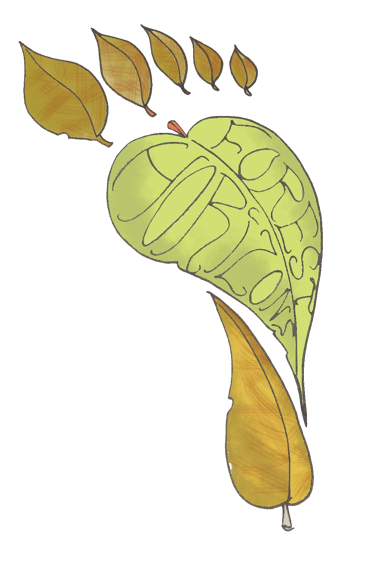The Free Wilders Bike Ride
An analysis of the bike ride as a political performance and how it balanced affect and effect
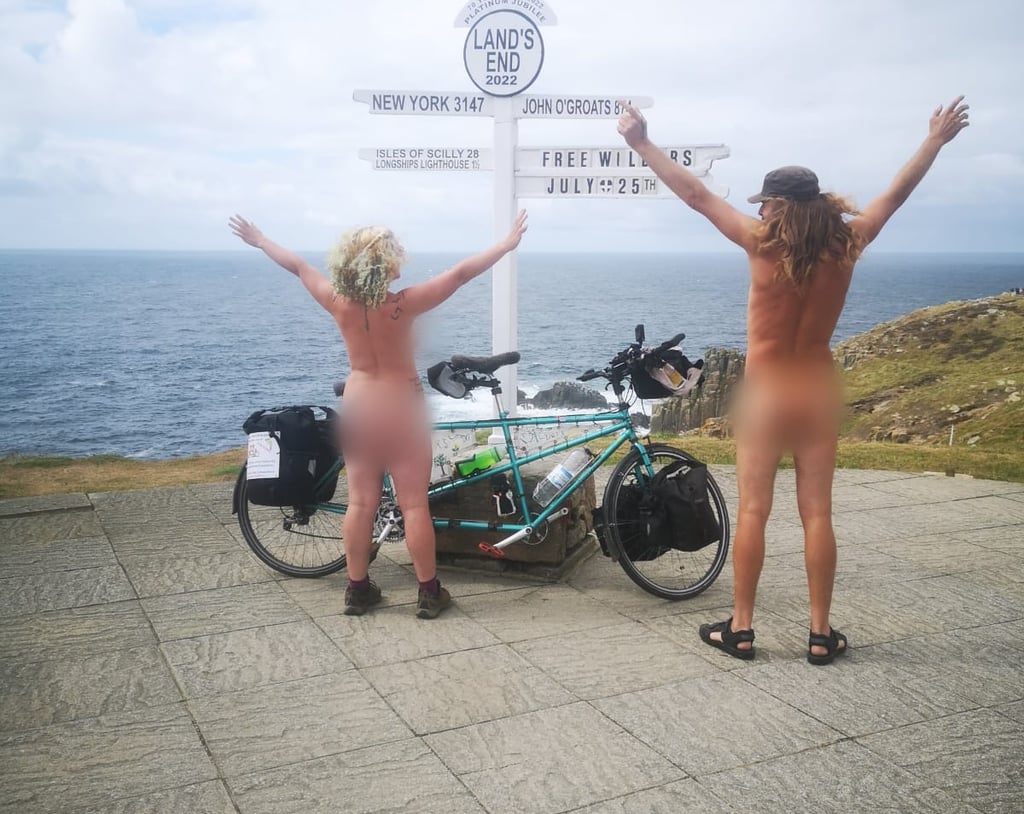

Essay question:
Analyse the practice of ONE or TWO practitioners or companies who seek to instigate political change through their work. What balance is apparent between affect and effect in these examples? How does this balance contribute to the impact of the performances on spectators or participants?
Introduction
This essay will analyse a naked charity bike ride project created in 2022 by a group of four people, collectively calling themselves The Free Wilders. It will focus on how it balanced affect and effect as a form of political performance. The Free Wilders group consisted of two male/female couples, each couple riding a tandem bicycle between John O Groats in Scotland and Lands End in Cornwall. Each pair started at opposite ends of the ride, one in Scotland and the other in Cornwall. They set off eight days apart and arranged a rendezvous point in Bristol where they could meet and share their experiences before continuing their ride. Instead of choosing the usual 874 mile route for this expedition, the group chose a longer 1000-mile route to include as many large towns and cities as possible and increase visibility for the ride.
The charities selected to receive funding through the project were Rewilding Britain and MIND, with the group raising just under £5000 to be split between the two causes. The group's aim was to raise awareness and funds for environmental causes and mental health, whilst also promoting body positivity.
The Free Wilders rode naked for as much of the distance as possible. Colin and Sadie, heading south from John O Groats, completed approximately 860 miles naked. Of the other couple, heading north from Lands End, Hannah rode approximately 600 miles naked (only covering up when cold) whilst Neil succeeded in completing the whole journey without getting dressed. Colin And Sadie welcomed people to join in and ride with them and were at times accompanied by naked supporters during sections in the Cairngorms in Scotland, Edinburgh, the Northeast, North Yorkshire, the Midlands and Somerset. The ride shared features of activist and participatory theatre such as described by Boal, who states:
Theatre is not a spectacle, but a means of communication. The actor and the spectator are no longer opposites, but one becomes the other; the spectator is no longer a passive observer but is a participant in the action (Boal, 2019 p. 122).
The Free Wilders blurred the boundaries of everyday life, spectatorship and performance. Schechner (2002, p. 22) broadly defines performance as “ritualised behaviour conditioned by social, political, and aesthetic contexts”. From this perspective, the ride can be understood to be a consciously-staged public performance.
The term 'affect' is used to describe the emotions and feelings that the ride provoked with elements such as surprise, vulnerability, humour, and courage. These states were evoked in both the participants and the observers in encounters on the streets and online. Alongside this, the term effect refers to its measurable outcomes, such as media coverage, donations, community engagement and changes in attitudes and opinions towards mental health, the environment and body image. An aspect that will be explored is how the Free Wilders ride worked as a form of political theatre and therefore the argument presented will be that the mission created a balance between affect and effect and that this was critical for the impact of the ride.
Context and Background. Was it theatre or just a stunt?
To the casual observer the Free Wilders ride might have looked solely like a fundraising stunt; a quirky way to raise money. Closer inspection, however, would reveal more depth to its purpose. It sat somewhere between activism, public performance, or even a kind of guerrilla theatre, with elements of protest and physical storytelling. Wole Soyinka says of guerilla theatre, in an interview with Harry Kreisler:
What I call guerrilla theatre for instance can respond immediately to, some people call it the living theatre, some call it the newspaper theatre [sic]. Whatever it is, street theatre, it can respond immediately to both events and the changing pattern of events. It responds to the dynamics of any situation (Kreisler, 2008).
Some might say it was not theatre at all and that it was just a publicity stunt, a creative way to get attention; it did not follow a script or on a stage, and it happened in real time, in public. But there was a clear performance throughout; the nudity, the tandem bikes, the banners and art decorating the bikes, the waving and smiling, the planned photo shoots and the many photo opportunities that inevitably presented themselves along the way. All these things were done with the audience in mind; on the streets, their followers on social media, and people reached through mainstream news, radio and television media. Whether the audience regarded is as theatre, a protest, or just a crazy idea, the ride made people question what is considered normal in public spaces.
Legally speaking, since 2018 and according to the College of Policing guidelines for England and Wales and guidelines from Police Scotland, public nudity in the UK is legal if there is no intention to cause alarm or distress. However, nudity is often policed as though the law is a grey area and open to interpretation. This added another layer to the Free Wilders’ ride. The College of Policing (2024) refers to this as “passive public nudity” and gives examples of sunbathing, swimming, and going for a bike ride. Unfortunately, not everyone is aware of this, including some police officers, and this lack of clarity has on occasion led to unwarranted arrests and misunderstandings. As Malcolm Boura from British Naturism states; “All too often we see innocent Naturists falling foul of the law, not because of their actions, but because of confusion within the law and a lack of understanding by the police and CPS” (Boura 2016). A particular case which highlights misinterpretation is the journey of Stephen Gough, better known as the Naked Rambler. He walked the length of the UK in the early 2000s. He was arrested multiple times for simply being naked in public and spent years in prison because he refused to wear clothing. The specific law covering nudity in public comes under Section 5 of the Public Order Act 1986 which states that it is an offence if someone “uses threatening [or abusive] words or behaviour, or disorderly behaviour, … within the hearing or sight of a person likely to be caused harassment, alarm or distress thereby”. At the time this was interpreted in a way that assumed nudity would automatically cause distress; indeed, it was likely that the law would be enacted even in the absence of a complainant because it was assumed that it would cause alarm or distress to someone. That changed in England and Wales around 2018, when police guidance was updated to say that passive nudity is not a criminal act (College of Policing, 2024). Despite clarification from the College of Policing, this misconception can still be found in the policing of public nudity.
Scotland, however, retains a more ambiguous approach with Police Scotland not having its own version of the updated guidance and instead handling things on a case-by-case basis (see Appendix 2). While they may consider the English guidelines, there is often uncertainty regarding how to approach public nudity. Before the Free Wilders set off, many people in the naturist community believed the Scottish leg of the ride would end in arrest. But remarkably, Neil Cox, one of the Free Wilders riders, completed the section of the ride through Scotland, naked, without arrest or even police interaction. This outcome speaks volumes about how the public positively responded to the ride and will inform the basis of an issue to be addressed later; how the ride affected the public and in turn then effected change in the policing of the ride.
Despite the legal ambiguity, the ride was clearly more than just a legal test. The Free Wilders used performance to shape how people perceived their purpose and intentions. Riding a tandem, for example, had a practical benefit. It is difficult for two long distance riders to keep the same pace and speed; it is normal on cycling expeditions to become separated for periods of time. This could lead to awkward and potentially unsafe situations for solo naked cyclists riding in isolated countryside areas or through populated city centres. A tandem overcomes this problem, but it also added a theatrical, playful quality that helped to make the sight of two naked cyclists feel more whimsical than confrontational. The landscape was the stage, with photos taken at famous landmarks like castles, public art and in natural beauty spots across the length of the UK. They smiled, waved, and interacted with people on the journey which created a gentle, joyful atmosphere. To the observer it felt spontaneous, but there was intention behind it. It was physical theatre about freedom, vulnerability, and reconnection. They stripped bare and the message was to strip back to what really matters; our natural world, mental wellbeing and learning to love the skin we are in. For those who saw the ride, it created a moment of disruption in their daily routine. This is what theatre often aims for, something unexpected that makes you stop and reflect, as Levy (2005) states, theatre 'teaches' and even if it does not do this should always do no harm.
Survey
A short, open-response questionnaire was distributed to individuals who had either participated in or followed the Free Wilders ride. Thirty-three responses were collected, all anonymised and used with informed consent. The questionnaire aimed to gather qualitative insights into participants’ emotional reactions (affect) and perceptions of the ride’s social, political, and cultural impact (effect). The survey has limitations since uptake engagement came only from supporters of the ride, but there were other incidents, social media posts and commends, that revealed negative attitudes from the public towards the riders. These will demonstrate the realistic and balanced approach to the analysis.
Efficacy vs Entertainment
Performance and theatre for change must deliver a message, and the audience must be entertained in order that the message be effectively delivered. There must be a balance between message and entertainment, so that the message does not get lost. Too much efficacy and the message risks becoming dry or preachy, too much entertainment and its value might be drowned out in laughter. Schechner (2003, p. 130) reflects this stating, “no performance is pure efficacy or pure entertainment” and the Free Wilders ride had plenty of both. The ride was designed to speak to people about body freedom, the importance of nature and the environment, mental health and wellbeing. It carried powerful messages and could easily have come across as too moralistic. The entertainment and attention, though, came from the nakedness.
In contemporary film (nakedness) has sometimes connoted vulnerability, humiliation or comic transgression: almost compulsory in teenage comedies is a scene of male nudity in a public space for comic purposes (Cover, 2003 p.53).
Despite its legality, it is rare to see naked people in public. The appeal of a naked couple on a tandem bike came from the novelty, surprise, curiosity, and humour it created. Their appearance gave off feel-good vibes, catching sight of them spoke of freedom, positivity, and of course, enabled charity fundraising. The efficacy side of the ride was in its goals of raising money for charities, spreading messages about rewilding and nature connection, promoting mental health, and body positivity.
Before the ride, it was not clear how being naked would affect the overall presentation. Changes to the Law over the preceding few years reassured the riders that arrest and imprisonment was unlikely. Even if it happened, it would probably be short-lived and would be followed by release which would potentially provide a portal to more media access and coverage. Also, since the ride was legal, the hope was that the mission would avoid negative or sensationalist press. Riding tandem bikes added to the humour and visual interest, but the hope was that it wouldn’t overshadow the ride’s core messages in relation to this Schechner (2003 p. 130) suggests, “efficacy and entertainment are not so much opposed to each other; rather they form the poles of a continuum”. Therefore, the aim was to strike a balance that created emotional impact (affect) and encouraged real-world action (effect).
Entertainment provided the platform to deliver the message. If people felt emotions like joy, laughter, surprise or curiosity they would be more likely to listen to and connect with the message. Entertainment communicated a message, but it only worked if the message was clear. It would be easy to just count likes, views, or shares as a marker of success, but going viral can sometimes mean the entertainment landed while the message did not. Too much entertainment value and the messages are left unheard. What the Free Wilders were looking for were shifts in perception, behaviour, and to potentially elicit shifts in policy. However, the entertainment element was what kept people watching, seen in social media shares, articles, and TV appearances, but again it had to be substantiated with meaning.
Timing also played a role. A decade earlier, and the riders might have been jailed like Stephen Gough, the Naked Rambler. In the summer of 2022, when the ride took place, we were all coming out of the Covid-19 lockdowns and planning how to reconnect with the world, friends and family. People were talking of going on holiday and hosting parties. The nakedness connected with a hunger for freedom that people were feeling. A sense of release and reconnection came through in responses to the survey. This word cloud (Fig. 1), generated from responses to the questionnaire about the ride, shows the most frequently mentioned feelings were happiness, proud/pride, free/freedom and joy/joyous. Note that the words; anger, anxious, distress, fear, sadness and worry was all in support of the ride rather than against it. They express feelings of support that the people surveyed felt following an attack on the two of the Free Wilders. The incident happened in Scotland when a driver intentionally
Fig. 1 Unsworth 2025
drove his car into one of the tandem bikes and knocked the riders off, which will be discussed in the following section regarding how it affected people following their progress, and how it added gravity to the serious message behind the ride’s apparent frivolity.
The sheer distance of the ride and the commitment from the riders also added weight to the messages. If it had just been a short naked dash through a city, it likely would have been regarded as a stunt. But 1,000 miles is a big number and a distance that most people will never cycle. Neil and Hannah, heading north, were more used to engaging in physical fitness and regularly partake in expeditions; they were fit and prepared for the ride. They rode a good quality racing tandem bike, travelled light and rested well by staying in hotels every night. By contrast Colin and Sadie, heading south, were not as used to this level of activity. This disadvantage was compounded for them by riding a cheap tandem bike that they bought for £160, carrying gear and equipment they needed for wild camping. This added time on to their journey; Neil and Hannah completed the ride in 12 days while Colin and Sadie took 23 days. However, this gave extra layering to the ride to help balance the efficacy of the message with the entertainment value. In terms of fitness and exercise, Alemdag et al. (2016, p. 2) states in; Social Appearance of Fitness Participants that “Adolescences and those aiming at losing weight demonstrated more social appearance anxiety compared to young adults and those aiming to keep fit”, and that “exposure to non-idealised naked bodies has a positive impact on body image, and, ultimately, on life satisfaction.”. Colin and Sadie’s more normal appearance and their struggle with the kit and equipment added a layer of both vulnerability and relatability to the ride for many public observers.
The most-asked questions from the public were (in order): “What about the chafing?” followed by “Is it legal?” You can see this during the interview with Colin and Sadie on ITV’s This Morning with Phillip Schofield and Holly Willoughby. (Fig. 2) (The Free Wilders Facebook.com, 2025)
Fig. 2 Unsworth 2025
The fact that chafing was always the first question shows that people immediately recognised the seriousness and determination behind the ride. The Free Wilders solution to the issue of chafing was given consideration before they set off on the ride. There is no precedent for long distance naked cycling, so inspiration was taken in the form of a strategy used by some long-distance ocean-going kayakers, sitting bare bottomed on a sheep skin. The Free Wilders used leather Brooks saddles (a favourite of long-distance cyclists) with custom-made merino sheepskin covers to help prevent chafing. When chafing did happen, it gave an opportunity to talk about nature connections; Sadie used the herb Yarrow picked from the roadside to cure her wounds. This also tied into to the ride’s message about connection with nature and added a further layer to the storytelling.
Analysis of Affect
Once the Free Wilders began their journey, the message was conveyed through emotional affect. Although this was presented clearly on their website and social media pages and the banners on their bikes, they could only be seen and understood on close inspection. Newspapers reported on them as far away as New York and Tokyo, and lazy reporting meant that many of the newspaper reports about them they simply quoted words from the Rewilding Britain website, “restoring ecosystems to the point at which they can look after themselves”. This got an important message out, but it needed something to trigger the journalist’s curiosity.
In Affect, Imagery and Consciousness, Tomkins (2008, p. xv-xx) asserts that there are nine affects; Surprise (startle), distress (anguish), anger (rage), enjoyment (joy), interest (excitement), fear (terror), shame (humiliation), dismell, disgust and “As humans, we are motivated to savor and maximize positive affect”. The affect is the initial response; “The affects are physiological mechanisms easily visible on the face of the newborn and although muted through the process of maturation” (Tomkins, 2008 p. xx). It is what we feel, the initial response to stimuli. Consequently, emotion is the interpretation of that feeling, and cognition is when this is thought about and processed. When people saw the Free Wilders, on the streets, on social media, in mainstream media or on TV, they felt something. This was achieved because of the disruption that they created: it is highly uncommon to see naked people in public. In Social Nudity and the Body Taboo, Warren (1933, p. 174) asserts that “when any tabooed part of the body is exposed, the response in the observer is shock”. The word cloud (Fig. 1) generated from responses to the survey shows that the most frequently mentioned feelings were happiness, proud, free and joy. The Free Wilders themselves can testify to this, they often said that cheers and laughter was the most frequent response, often raucous laughter. Grahame Cooper, who rode with the Free Wilders, said “Always nice to have some positivity to kick off the pretty but hard climb up from Belmont. I could still hear hysterical laughter from half way up the hill.” (Cooper, 2022). The comedy element of the tandem bike helped to turn the shock into positive emotion, which is something Tomkins (2008 p.xx) notes, that “As humans, we are motivated to savor and maximize positive affect”. The Free Wilders ride had feel good vibes and people's curiosity was rewarded with smiles and waves. It seemed playful and joyous.
If something affects you, it means that it has an influence or impact on you, causing a change or reaction. Stalpaert et al. (2016 p. 48) states that “…the relationship between affect, emotion and cognition becomes more explicit since one relates to the other, through habit and memory.” For the Free Wilders, there were other tactics they employed for positive affect, such as gender normativity. Each bike seated a male-female couple. Colin and Sadie were partners and Neil and Hannah were friends. Neil specifically recruited a female riding partner because a gender balanced couple is less challenging for the public. Judith Butler theorises that “performing one’s gender wrong initiates a set of punishments both obvious and indirect, and performing it well provides the reassurance that there is an essentialism of gender identity after all” (Butler, 1988 p. 528). The Free Wilders wanted to get their messages across, while being somewhat constrained to perform their gender in socially accepted ways this enabled them to convey their message. Also, the seating arrangement of the tandem was traditional with the male rider as the pilot, at the front which again conforms with the concept of gender roles and performance. When riding through busy cities it makes sense to have the more experienced and skilled rider at the front, the one who is most experienced at road craft. In tandem bike racing, however, the strongest and most powerful rider is the stoker, the rear rider. But the Free Wilders chose the traditional set up with the man in control and the woman on the back. This arrangement reflects patriarchy; the Free Wilders were essentially performing heteronormativity.
When examining the responses from the survey, they reflected the process of affect, influence and change.
A tiny bit shocked at first but then Colin and Sadie’s authenticity and all round positivity and loveliness convinced me it was really nothing to feel shocked about. Then I thought it was a wonderful thing to do. (Unsworth, 2025)
To support how we felt on the ride:
Joyful to see the freedom of both body and mind. You always look so happy, and your happiness is infectious. (Unsworth, 2025)
Inspiring hope for change:
It made me feel uplifted, with a slim glimmer of new hope for the future of social acceptance of natural, non-threatening bodies (Unsworth, 2025)
Affecting change:
People often see the naked human body as something inherently sexual, which can be damaging and create shame. I felt that the ride broke down those barriers, even if its not the intention of those involved. And honestly just looks like a lot of fun! (Unsworth, 2025)
An important part of the success of the ride was how the riders themselves were affected. Riding a bike naked in public is a way of liberating yourself from body shame, and it feels good. This is reflected by responses from people who joined in and rode sections with the Free Wilders to the question Can you share a memorable moment from the ride that had a strong emotional impact on you?
We stopped at one point and we were standing beside our bikes. At first I felt exposed and unsure but you both made me feel so welcome and not judged. I was relieved, thankful and joyous. (Unsworth, 2025)
How the riders felt helped to create the ride’s feel-good vibe.
The questionnaire only surveyed supporters of the ride, but not everyone felt positive affect upon seeing the riders. This was strongly demonstrated when a driver in Scotland deliberately drove his car at Colin and Sadie, knocking them off the bike. However, this created a wave of support and visibility for the Free Wilders and their mission. Newspaper coverage across the UK (Fig. 3) brought the ride to the attention of senior officers from Police Scotland. The officer in charge of the case said to one of the Free Wilders in a phone call about the case “I would like to apologise on behalf of the whole of Scotland”. Responses from the survey also carried this feeling, with a significant level of anger felt when followers heard about the attack.
The incident in Scotland when a horrible, narrow minded individual tried to harm them. The anger and fear that I felt was palpable.
The reaction online of the vast majority of people regarding the unfortunate road incident in Scotland, renewed my faith in people (Unsworth, 2025)
(Fig. 3. BBC News online, 2022 Naked charity cyclists left terrified after Perthshire road rage attack - BBC News)
The incident happened because the nudity affected someone negatively, but the net result was positive. The charity donations on their JustGiving page went from a few hundred pounds to over £4,000 in the next few days. The Free Wilders succeeded in turning a deeply negative response into a positive outcome.
Analysis of Effect
The goal of the mission was to raise money for the causes and awareness of rewilding, mental health and body positivity. It was inevitable that a disruption caused by nudity would mean that most of the discussion focused on nakedness and body positivity. The more tangible effect was simple: how much money did they raise? Their hope was to achieve £1000 in donations; this would validate the mission as being more than just an exhibitionist stunt. Colin and Sadie had 300 miles under their metaphorical belt when the attack happened, and by then they had raised less than £500. This put them on track for their £1000 target, but the effect of the assault and the resulting nationwide publicity was that the donations started to rise sharply. By the time they had reached Newcastle they had received over £2000. In total, with online donations and cash donations along the ride, the team raised just under £5000 (Unsworth & The Free wilders, 2025).
The ride was reported in numerous broadsheet and tabloid newspapers, online articles by the BBC and other news outlets. Neil and Colin were interviewed by local radio stations along the way, and after the ride had finished Colin and Sadie were invited to ride their bike naked on to the set of This Morning to be interviewed by Philip Schofield and Holly Willoughby.
As can be seen in the results of the survey, many followers remain devoted, especially those who joined in with the ride.
Fig. 4 & 5
The two main risks of the mission were that the entertainment value of the ride would drown out the message, and that seeing naked people in public would affect negative feelings. There was considerable discussion online, but the set of screenshots from the Liverpool Echo Facebook page (Fig. 4 & 5) summarise the extent to which members of the public were offended or disgusted. The first comments on both screenshots and the last one on the first screenshot (Fig 4), reveal negativity regarding the nakedness and focus on the idea children need to be protected from the perceived harms of nudity. Again, this reiterates engrained societal stress regarding passive nudity.
Responding to this was difficult to balance for the Free Wilders because hiding normal bodies from children is arguably damaging and leads to body shame and is detrimental to body image. This is a difficult argument to pursue on public forums because opponents to the idea of public nudity can, and inevitably will, interpret it to be that it is the purpose of the nudity to socialise with children. The Free Wilders needed to maintain a positive energy to keep public engagement on track. However, they found that it was not necessary for them to personally challenge this negativity because members of the public would negotiate this in their stead. This can be seen in other comments. (Fig 6-11).
(Fig 6-11. Liverpool Echo News 2023).
Did the Free Wilders ride effect change in individuals?
In answer to the survey question “Did the event change the way you view body positivity or environmental causes?”:
Definitely. Seeing how many people just didn't care made me feel like we'll why should I be hiding my body. Bodies are just bodies and that's wonderful and beautiful- it made me feel great.
It did, I realised anyone can champion a cause, raise awareness or actively help to improve our environment.
It definitely changed my view of body positivity
Did the Free Wilders effect change in society?
This is difficult to measure and quantify, but noticeable was the lack of any negative press. It is hard to believe that the same would have happened if the ride had taken place ten years earlier at the time of the Naked Rambler. This could be due to social shifts that the Free Wilders were just marking with their ride, rather than social change because of their ride. However, there was a change in policing in Scotland following the attack on Colin and Sadie. The case probably sparked conversations in police stations all over the country, thereby signalling a political shift and greater understanding of the law surrounding nudity. Recommendations for changes to the policing of naturism were recent, and Colin and Sadie had four encounters with the police between John O Groats and The Bridge of Earn where they attack happened. A week later Neil and Hannah crossed into Scotland. Neil had managed ride naked all the way to through England, but Scotland was the real challenge, however against expectations he made it. He passed numerous police cars along the way, but they never challenged him. It is my opinion that this must have been because of discussions about policing, triggered by the attack, and a decision to let the Free Wilders pass without challenge., This may well underpin more leniency and understanding regarding not only social but also political frameworks. However, due to the unique nature of the event, if others choose to be naked in public without being attached to a fund-raising event, they may not receive the same level of support.
Combining Affect and Effect
Balancing emotional affect and the resulting effect was at the core of the ride. The response to the ride, from the public on the streets, people seeing stories of their journey online and on social media, on the radio and TV, was overwhelmingly positive. The fundraising target was smashed. Also, two responses from the survey mentioned the Free Wilders representing a sense of community for people.
I thought it was great. I think the sense of community, belonging and connectedness with ourselves, others and nature, has been slipping away over the decades.
Pride in participants, respect for their views and beliefs, pleased to see how welcomed by the greater community. (Unsworth, 2025)
Alain Touraine (2000) critiques the idea that well-being should come from integrated communities, instead suggesting individual rights might be more effective for reflecting diversity and achieving community harmony. He states:
Has not the pursuit of common good become an obsession with identity, and do we not need stronger institutional guarantees of respect for personal liberty and human rights rather than more integrated communities? (Touraine, 2000 p. 112).
The Free Wilders ride was full of self-expression, and it was bold. As Nina Metz (2016) of the Chicago tribune puts it, “There really is something bold and exciting about actors so willing to strip themselves bare, both emotionally and physically”. The image and messages of the Free Wilders spoke to their followers about a dream of an idyllic future where community can exist without body shame. In their analysis of Habermas’s theory of communicative action, Kuppers and Robertson (2007 p. 31) observe “the very assumptions of his theory of communicative action presuppose the social and cultural context of a shared life-world.” The followers of the Free Wilders shared a dream of how the world should be.
Conclusion.
The Free Wilders ride can be seen as striking a good balance between efficacy and performance. The emotional affect of the spectacle of the riders was successful in communicating their message, and they effected change. Using vulnerability, humour and disruption they opened conversations about rewilding, mental health and body positivity. Sometimes it caused anger, but mostly it created feelings of joy and happiness and a yearning for a better world. The nudity created a disruption in people’s daily life and caused them to pause and reflect. We are used to the idea that nakedness is challenging and might be accompanied by unpleasant behaviour, but the Free Wilders were never aggressive or confrontational. This is why it worked. Fun and kindness made it easy for people receptive to the deeper messages about nature connections and mental wellbeing and body acceptance.
The responses to the ride, seen in the reporting, comments and conversations, show that it reached and impacted people's perceptions of society and community. It made them laugh and contemplate their individuality and place in the world and provided a foundation for hope. The premise was not just about money but also awareness. The Free Wilders did not just talk about a better future, for a while they lived in it and rode through it.
One respondent to the survey who was with the Free Wilders at the end of the ride captured the impact of the ride well with an answer to the question “Can you share a memorable moment from the ride that had a strong emotional impact on you?”
“That group of strangers, in a Public House, were able to have a Body Positive conversation for an evening, out of the blue. I often wonder if the effect of that friendly, interested chat, had a lasting affect on those folk & that pub.” (Unsworth, 2025)
References
Alemdag, S., Alemdag, C. and Ozkara, A.B. (2016). SOCIAL APPEARANCE ANXIETY OF FITNESS PARTICIPANTS. Baltic Journal of Sport and Health Sciences, 3(102), p.2. doi:https://doi.org/10.33607/bjshs.v3i102.58.
Anon, (n.d.). College of Policing. Public Nudity Advice and Decision Aid. [PDF (document image)] College of Policing, 2024. https://library.college.police.uk/docs/college-of-policing/C849IO118-public-nudity-aid-revised.pdf
Boal, A. (2019). Theatre of the Oppressed. Pluto Press (UK), p.122.
Brown, L. (2015). This Is Where You Can Be Naked in Public in the UK. BBC News. [online] 11 Jun. Available at: https://www.bbc.co.uk/news/newsbeat-33092812
Butler, J. (1988). Performative Acts and Gender Constitution: an Essay in Phenomenology and Feminist Theory. Theatre Journal, 40(4), p.528.
Cooper, G.S. (2022). Video. [online] Facebook.com. Available at: https://www.facebook.com/GrahameCooper/videos/1189653279046249?idorvanity=364726753113141
Cover, R. (2003). The Naked Subject: Nudity, Context and Sexualization in Contemporary Culture. Body & Society, 9(3), p.53. doi:https://doi.org/10.1177/1357034x030093004.
De Vries, B. (2018). The Right to be Publicly Naked: A Defence of Nudism. Res Publica, 25(3), pp.1–2. doi:https://doi.org/10.1007/s11158-018-09406-z.
Gregg, M. and Seigworth, G.J. (2010). The affect theory reader. Durham: Duke University Press, pp.118, 120.
Kreisler, H. (2008). Conversations with History: Wole Soyinka. YouTube. Available at: https://www.youtube.com/watch?v=wosbdri9dRc (at 19m 24s)
Kuppers, P. and Robertson, G. (2007). The Community Performance Reader. Routledge, p.31
Public Order Act 1986 (1986 c. 64) [online]Available at: https://www.legislation.gov.uk/ukpga/1986/64/section/5
Levy, J. (2005) Reflections on how the theatre teaches. Journal of Aesthetic Education, [online], 39(4), pp.20-30. Available at: https://www.jstor.org/stable/3527389
[Accessed: 3rd May 2025)
Liverpool Echo (2023). This raised a few eyebrows. [online] Facebook.com. Available at: https://www.facebook.com/theliverpoolecho/videos/1528093874274428
Metz, N. (2016). Nudity on stage – why it always changes the dynamic. [online] Chicago Tribune. Available at: https://www.chicagotribune.com/2016/04/21/nudity-on-stage-why-it-always-changes-the-dynamic/ [Accessed 12 Apr. 2025].
Naked charity cyclists left terrified after Perthshire road rage attack. (2022). BBC News. [online] 11 Jul. Available at: https://www.bbc.co.uk/news/uk-scotland-tayside-central-62121867. [Accessed 11 Apr. 2025].
Naturism, B. (2016). Legal Guides - Public Place Naturism. [online] British Naturism. Available at: https://www.bn.org.uk/files/file/739-legal-guides-public-place-naturism/
Naturism, B. (2025). British Naturism. [online] British Naturism. Available at: https://www.bn.org.uk/policing/?fbclid=IwY2xjawJuRwlleHRuA2FlbQIxMAABHrPaVEQirMrSh9q4Q-oYKyGkVMBS3lhhdWQhuc9xy6AXcHtUQEeans9i54uk_aem_g9CLj0CRSokvunijPctvZw
Schechner, R. (2002). Performance Studies: An Introduction. third edition ed. Routledge, p.22.
Schechner, R. (2003). Performance Theory. Taylor & Francis Routledge, pp.130, 134.
Shaw, D. (2014). Naked rambler Stephen Gough loses human rights case. BBC News. [online] 28 Oct. Available at: https://www.bbc.co.uk/news/uk-england-29800016
Stalpaert, C., Pewny, K., Coppens, J. and Vermeulen, P. (2016). Unfolding spectatorship : shifting political, ethical and intermedial positions. Gent: Academia Press, p.48
The Free wilders and Unsworth, C. (2025). It’s not every day you get to ride a bike naked on to the set of This Morning. [online] Facebook.com. Available at: https://www.facebook.com/share/r/1F1abzErWZ/
Tomkins, S.S. (2008). Affect imagery consciousness : the complete edition. New York: Springer Pub., pp.xv–xx.
Touraine, A (1995). Critique of Modernity. Wiley-Blackwell, p.112.
Touraine, A and Macey, D. (2000). Can We Live Together? Stanford University Press, p.65.
Unsworth, C. (2025a). Questionnaire consent form (Responses). [online] Google Docs. Available at: https://docs.google.com/spreadsheets/d/e/2PACX-1vTQSy1jIAizKfANhNbjCswikqNDUg8Fin7e5JUp-vsPbOxFhg72_fqYuZx2-PbeZwl2ZEmw-2DYmeao/pubhtml
Unsworth, C. (2025b). Word cloud of participant responses to questionnaire on Free Wilders ride.
Warren, H.C. (1933). Social Nudity and the Body Taboo. Princetown University, pp.174–175.
Appendix 1.
Survey questions and responses.
Q1. How did participating in or witnessing the ride make you feel at the time?
For me, getting the chance to join in the ride was a great experience. I’m not a stranger to public nudity, having participated in naturism (occasionally) over about 40 years, and having ridden on a number of WNBR’s since 2014. But, being a small part of the Free Wilders journey was something different. I think because it was only the three of us riding, and mostly on fairly quiet country roads, through hamlets and villages, even through a ford across a stream at one point. It was quite idyllic, in a way, and showed me that it could (indeed should) be possible to travel this way wherever we happen to be in the UK, and that maybe we’re not as prudish a society as we’re sometimes given to believe. As with the WNBR’s it might not have been apparent to any onlookers that there was a message and purpose to the journey I think that the Free Wilders and particularly Colin and Sadie made excellent use of the media along the way, even turning negatives, such as the incident with the motorist in Perth, I think it was, into positives.
Interested - wanted know why they were doing it and what their route was. I am already aware of their stance on body positivity and support their cause.
A tiny bit shocked at first but then Colin and Sadie’s authenticity and all round positivity and loveliness convinced me it was really nothing to feel shocked about. Then I thought it was a wonderful thing to do.
United. Joyous. Belonging. Accepted. Brave. Rebellious. Free. Less self-conscious. Confident. Nervous - yes, both confident and nervous! (all of these blended together)
I was pleased that people can stand up for what they truly believe and participate in an activity that really shouldn't be made into something that it's not.
I felt proud of them for doing it, and I felt very protective of the right to be naked. I felt worried for them during certain events, seeing comments etc.
Interested - wanted know why they were doing it and what their route was. I am already aware of their stance on body positivity and support their cause.
Joyful to see the freedom of both body and mind. You always look so happy, and your happiness is infectious.
Cheerful, and at one point a bit scared!
Immensely proud of my wonderful friends
Delighted, excited and concerned.
It made me feel uplifted, with a slim glimmer of new hope for the future of social acceptance of natural, non-threatening bodies. As a woman however, & previously abused by male violence, I can always feel (my anxiety toward) the thin line .. of threatening, aggressive, nude behaviour - compared to that of a sweet, natural, pleasant interaction - I was also very aware of how a majority of folk have a very black & white view of subjects such as nakedness, both political & social - & there seems to be an inability now, in our post-Covid19, trumpian world, to debate subjects diplomatically anymore .. & simply agreeing to differ. Overall, spending real time with Colin & Sadie, was a massively positive effect on me.
Exhilarated, free, confident, but slightly worried about reprisals.
I thought it was great. I think the sense of community, belonging and connectedness with ourselves, others and nature, has been slipping away over the decades. Especially with the polarisation of the internet. People often see the naked human body as something inherently sexual, which can be damaging and create shame. I felt that the ride broke down those barriers, even if its not the intention of those involved. And honestly just looks like a lot of fun!
Vicariously liberated
In awe
I felt like I was helping to spread awareness of non-sexual-social nudity, naturism, natural living, nature and our (human) relationship to it and allowing the environment and ecosystems to recover naturally.
Inspired
Following the progress of the ride and the general positive response that Colin and Sadie largely received, gave me a warm feeling. It encouraged me to be more open with my own naturist pursuits.
Impressed at the ability of some people to follow in their personal views without fear of others negative opinions or comments.
I thought they were very brave to ride naked
Happy that someone else feels the same as myself when cycling nude..that is free from restricting clothes and able to breathe through my skin
Joyful
Good
Uplifted
Witnessing the ride online was really uplifting, it made me realise that there are others out there who feel the same as i do, and that i am not the only person with these views. The way the majority of society accepted Colin & Sadie was very reassuring. My own self esteem has never been high, but Colin & Saidie's actions have raised it considerably, and will hopefully continue to do so.
I really would have liked to join them for a section but don't live in UK so wasn't practical
It made me delighted that they are enjoying such freedom
For me there was a sense of pride, in both yourselves and myself. Normalising nudity and showing so many people all over the country that it is not something bad or wrong. It to see so much positive feedback was fantastic. Plus if course it was done for a good cause.
Q2. Did the event change the way you view body positivity or environmental causes? If so, how?
Yes. On positivity, that naked bodies are beautiful, whatever their shapes and sizes. We shouldn’t feel we need to hide them away or ever be ashamed. We are so much more than our bodies and can enjoy friendship having stripped away (literally) the issue of our bodies’ appearances. You can truly relax together in each other’s company.
I am already body positive, and I was hoping/expecting that Colin and Sadie’s quest would positively impact others… by accepting seeing naked bike riders they would come to accept themselves more. Regarding the environment, it showed that you CAN ride your bike most places and made a day to day journey look manageable in comparison.
No, it confirmed my view of body positivity. I do not have a wish to be naked myself, but I respect the right to express yourself in any way that makes you happy and fulfilled. And nobody should be judged by how they look or what they do or don't wear.
Definitely. Seeing how many people just didn't care made me feel like we'll why should I be hiding my body. Bodies are just bodies and that's wonderful and beautiful- it made me feel great.
I wouldn't say it's changed my view on body positivity as I have a pretty open view on the subject. I wasn't aware that the naked rides were to bring awareness to environmental causes.
I had never experienced body positivity beforehand. Following the cycle ride I couldn't believe the amount of support that was received. I personally am very environmental anyway.
I don’t think it changed anything, for me, as I have a little history in being seen naked, and with the WNBR movement being linked to environmental issues over many years.
It strengthened my feelings about body positivity.
I’ve always been an advocate of both causes.
Well no, I already run a wnbr
Yes, although my view on environmental causes has always been strong, my view on body positivity hadn't been tested much. I am much more vocal in my opinions now, especially on "intent" .. i.e when the aim is purely to effect positive change. I believe the affect on me of the Free Wilders' achievements gave me confidence to speak up (partly through my untreated adhd which worsened considerably, post menopause & mature years) & has left my forthright, opinionated diatribe strengthened, & boosted my ability to speak up for Body Positive attitudes.
It helped me to see that we can do things that previously seemed taboo unless they were large, organized events such as WNBR.
Despite not participating, I do think it has allowed me to appreciate my body, and that everyone is different, everyone's bodies can do different things, and they are all great and beautiful and natural. I alsobthink some of the criticism have opened my eyes up more to how far removed from nature we are as a species and that many humans see themselves as beyond or above nature.
It did, I realised anyone can champion a cause, raise awareness or actively help to improve our environment.
Longing (to join in)
I guess in some way it did change my perception of my own body freedom, I'd always been quite fearful of how others may perceive me as a naturist male. As I've become more open about my love of nudity my perception of my own body and my confidence has grown. From an environment perspective I have always been quite aware of the damage that we do to our environment so wouldn't say that my perception has changed that much.
Made me think more about possibly taking part in future events in support if in or near my area
I realised that I'm not totally comfy in my own body. Understanding we all come In Different shapes and sizes, and we should celebrate what we are given. Totally liked the zero carbon method of transport.
Not environmentally but body positively yes..it gives me more confidence in being nude outdoors and reinforcing that fact that my body isn't perfect nor is anybody else's
I support what the freewilders stand for
No as I am very body positive already
It has made me realise that most people aren't really bothered what you look like & accept you as a person for who you are. My own previous misgivings came from social conditioning & shaming, the idea that we should act a certain way, "do this & don't do that" and look a certain way. As someone who doesn't fit the promoted image of what "we should look like" according to the media & advertising, this ride has lifted me no-end. For that i am very grateful. As for environmental issues, these have been important to me for many years but feel that the ride brought the issues to a fresh & different audience which is a good thing in my opinion. So yes it did improve my outlook on both fronts & has uplifted me personally
Not about body positivity as I am already a seasoned naturist but I learned more about the rewinding movement and was inspired to find out more.
It helped me better understand the link between the two
It definitely changed my view of body positivity. So many naturists feel the need to be behind closed doors and your journey showed that it doesn’t have to be that way.
Q3. What emotions stood out to you during the event?
I was slightly envious at their bravery and confidence. I often see posts on FB when they have been into local bars naked and like reading the positive comments. Nudity doesn't shock me as I have a very open mind but it's not something I feel I could participate in. I was shocked by some people's negative reactions though, particularly the aggressive responses from some males towards Colin during one of the bike rides. But on the whole, the positive responses outweighed the negative and I enjoyed following Colin and Sadie's journey.
Mine or yours, or other peoples? I was aware you'd had a big fright being abused/knocked off by a passing driver, and were a bit cautious as a result. Other people just seemed to accept it. Mine, a bit anxious.
Again, very proud of your achievement and and your determination throughout despite scary situations. And the amazing community support and genuine care for you along the way was amazing.
I would have to say an overall feeling of joy at being albeit a small part of the Free Wilders journey.
Glee, wild joy, warmth, delight, excitement, kinship, then concern at the incident with the vehicle.
The love , curiosity,courage and the great response from the public.
Happy and exhilarated, although mixed with fear.
Pride and love
Admiration
Happiness.
In relation to the negative verbal & physical attacks, I was shocked that the Free Wilders' body positive awareness fundraiser had that violent level of affect on these people's fears & aggression. But, however, the overwhelming, infectious joy felt by those of us who supported their endeavors & shared in whatever small way their great results can continue to speak, positively & fondly, of their brave achievement.
Feeling of being free, and being inspired.
Everyone just seemed really happy.
A sense of freedom and fun
Proud of you and a little envious. You got some adverse reactions which were good because it’s a way of remaining grounded. It remind you that despite your own enthusiasm, this is met equally and opposite by people for whom generations of social co detaining has taught them that public nudity is wrong and only people who get a sexual kick from it do it. It is their right to have these beliefs just as it is your right not to. So this is a lesson to be embraced and when doing the ground work and PR ahead of such events the temperature of acceptance should be factored in. If in any doubt, don’t force it - for the welfare of participants and to avoid acrimony with the public, either more PR is needed or a change of route. By being considerate and respectful you reduce the risk of undoing any gains made relating to acceptance of public nudity. Suggestion: do something where the public can see the connection between the activity and nudity (ie where being nude would be a benefit to the activity) eg surfing 200 beaches around the UK. Or maybe take one of those inflatable assault courses around the UK to be done naked (care with friction burns though)
Happiness knowing that it is okay to be free from clothes.
Sadness knowing that some people respond to naturists with anger and violence.
Admiration at the fortitude of Colin & Sadie to complete such a challenge.
Freedom, happiness, love and liberation. We are told to live a certain way by society and breaking these boundaries is a step on the path to freedom.
Pride in participants, respect for their views and beliefs, pleased to see how welcomed by the greater community.
Happy that they were doing it but also abit of fear that someone might be hateful towards them for being different
Joy overall, sadness and anger when the participants faced abuse from a small minority of people.
Joy
Humility, love and being at ine with nature
The happiness & determination of Colin & Sadie. And wishing i could have been there to support them.
Admiration and respect for the participants and pleased that so many onlookers had such a positive response (despite the few idiots!).
Joy, freedom and liberation stood out to me.
Pride, joy, relief, general positivity.
Q4. Can you share a memorable moment from the ride that had a strong emotional impact on you?
A memorable moment for me, was as we were riding along a fairly straight stretch of country road, all three of us were aware of laughter coming from behind us, and gradually getting louder, and louder, until we were eventually passed, by a minibus full of obviously surprised, but very happy people. In hindsight, I wish that we’d actually been able to meet them. But, at least we had their smiles and laughter drifting off into the distance.
I've seen Colin being assaulted on one of the naked bike rides which upset me. Colin is such a lovely and genuine guy and Sadie a wonderful lady ( I've been foraging with Colin and Sadie) and for a member of the public to attack him, without having a conversation about why they were riding naked, really made me angry. It made me want to see Colin and Sadie succeed.
No specific moment, but each time I see a photo pop up on FB, it makes me smile. I also love that you tackle the negative remarks with kindness, respect and understanding. The consistency of your positive attitude, alongside your visual message of body positivity shines out in a sea of negative social media posts.
Honestly when that man tried to kill you on your bike with his car. I was really upset. I made it my mission to explain what you were doing e.g to people in work, my family and why it isn't a negative thing to try and raise awareness of laws and why it would be stupid if being unclothed was against the law.
We stopped at one point and we were standing beside our bikes. At first I felt exposed and unsure but you both made me feel so welcome and not judged. I was relieved, thankful and joyous.
Thinking about them crossing paths with the friends who were riding in the opposite direction, feeling a surge of pride and kinship.
The incident in Scotland when a horrible, narrow minded individual tried to harm them. The anger and fear that I felt was palpable.
Encountering some youths in a local park which is "A bit rough." Became worried the entire thing could go tits up at that point.
Seeing Colin and Sadie cycling along the road as if it was completely routine. (It probably was to them ☺️)
All of it the stops the beeping vehicles and local support.
When the Free Wilders departed on their final, monumental day, for the last 20 mile leg of the run (from one of their many, donated, overnight camping offerings) it felt incredibly uplifting for me, waving them off, as a witness to their incredible achievement, & the special, body positive affect they'd had on a small, traditional Cornish village, let alone the strong sometimes negative earlier reaction en route - we'd visited a local pub for dinner the night before, where the bar-staff had all heard of their fantastic efforts via the news & media. That group of strangers, in a Public House, were able to have a Body Positive conversation for an evening, out of the blue. I often wonder if the effect of that friendly, interested chat, had a lasting affect on those folk & that pub.
From the part I joined in on: a Chinese lady passing in a large car shouted "living your best life!" From the ride as a whole, the final ride into Landsend.
Honestly, just that everyone seemed happy, having a good time and seemed free.
The incident with the nutcase driver in Scotland
When you were knocked off your bike by that guy. That was horrible and unnecessary. But that was very sobering too. His rage was probably impulsive and reflects the cultural values held by him and his family.
Meeting The Free Wilders and journeying with them for a couple of days, learning about what drives them and how they view the world and how they wish to change it humbled me, 2 ordinary people with extraordinary presence wanting to make the world better, not for self aggrandisement but benevolence to all.
None really, just the photo's and the placements of items for media needs.
Probably the picture of them at Lands End..such an achievement against so many odds...gave me happy tears seeing Colin & Sadie made it❤️ When I say against the odds, I mean against possible problems with the Police from different forces, problems with society/public with some believing simple nudity is illegal in public..and people who commit hate crime against people who practice simple nudity..
When a car tried to run them off the road was distressing
I'm just so pleased to see them
Cycling through the Midlands, my neck of the woods
The reaction online of the vast majority of people regarding the unfortunate road incident in Scotland, renewed my faith in people, most people are decent supportive folk & those like the ones you came across in Scotland are in the minority. There will always be some who are against anything, no matter what you do, but this made me realise they are a minority.
Positive responses from the Police.
The riders’ dignified response to some nasty opposition had an emotional impact on me, confirming that what they were doing was right.
I don’t have one specific moment to be honest, just the pleasure of seeing your journey progress and the constant positive feedback.
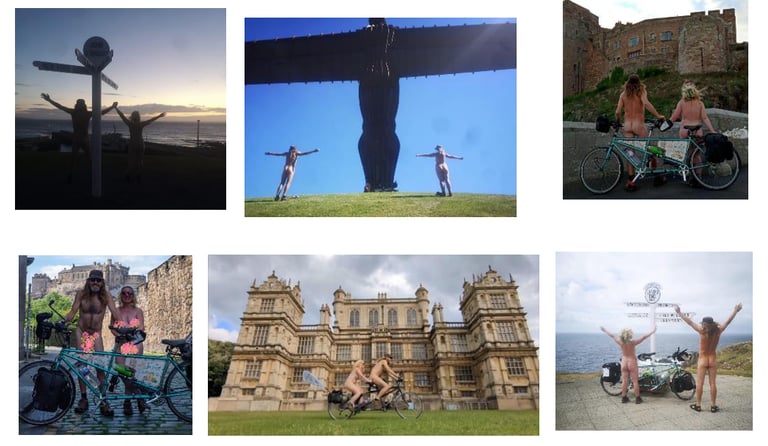

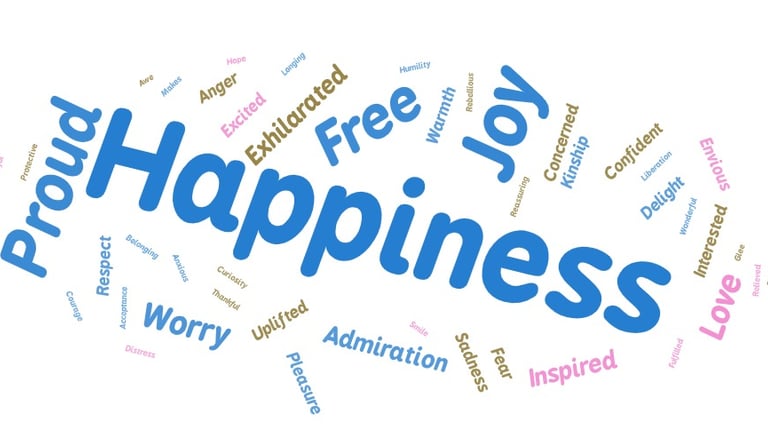

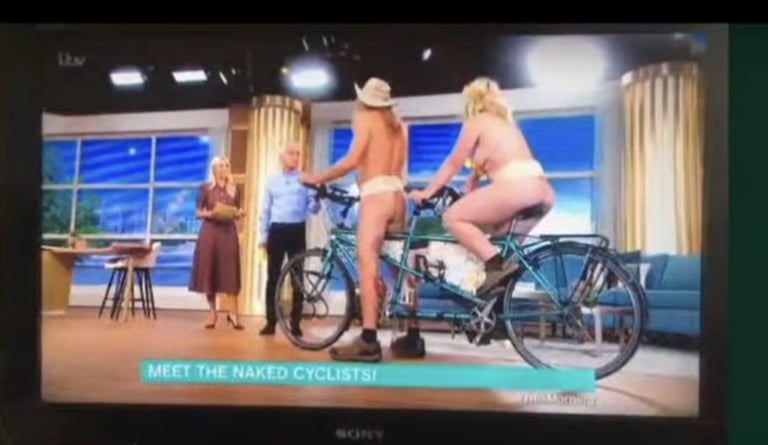

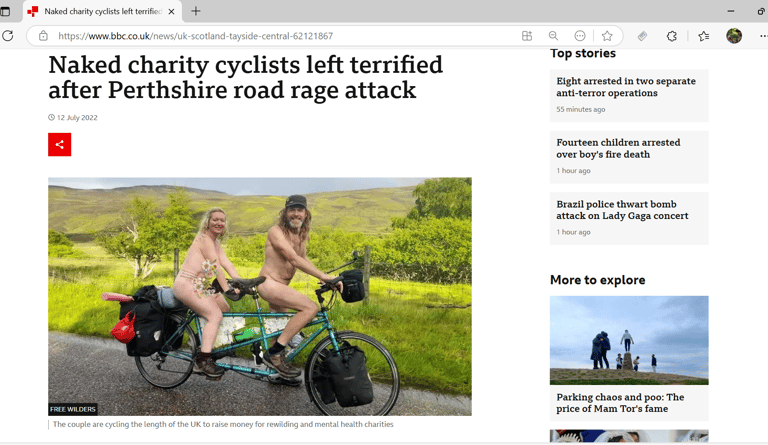

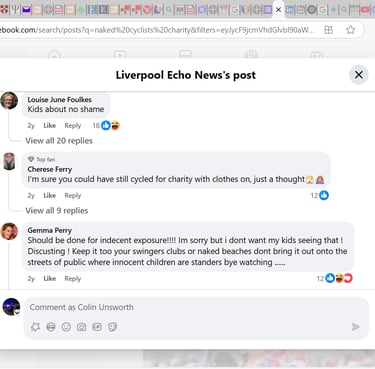

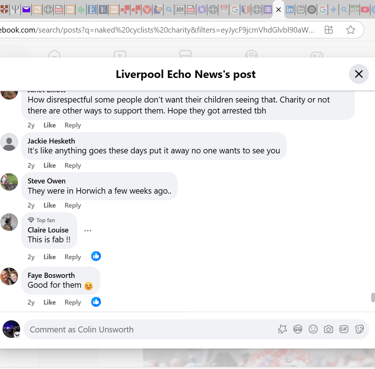

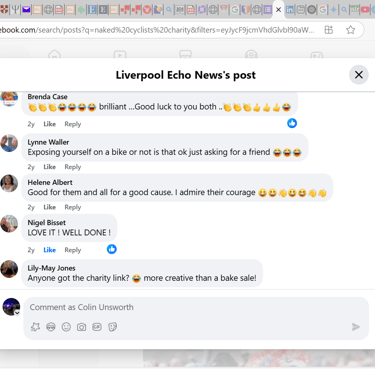

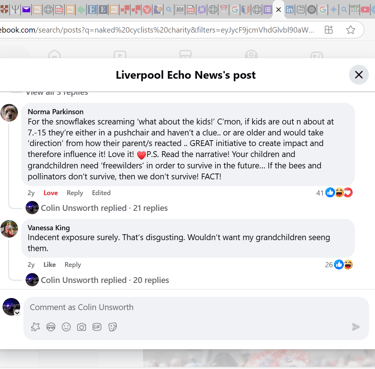

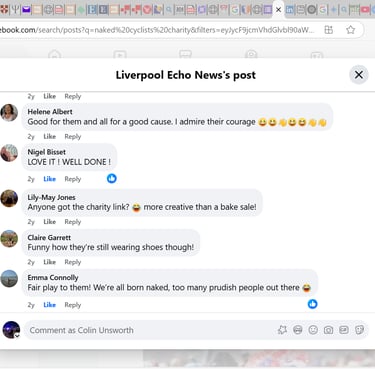

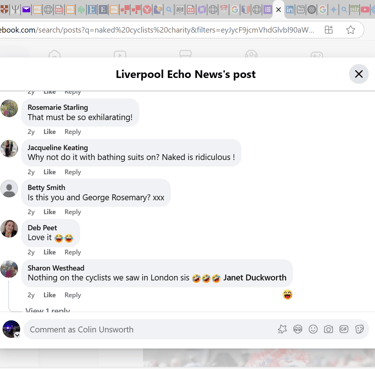

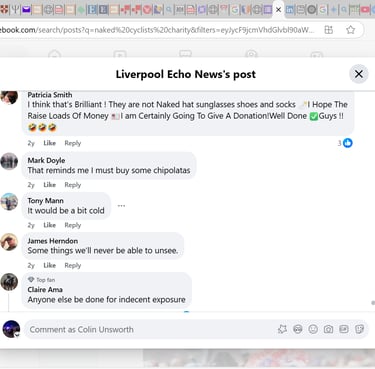

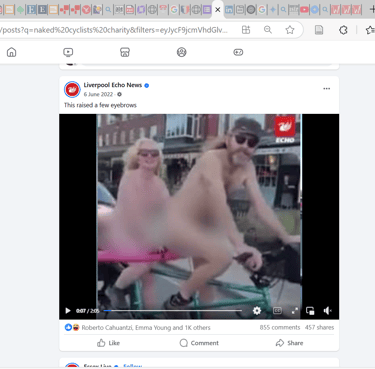

Get in Touch
Reach out with questions or feedback about my essay.
Subscribe for Updates
Stay informed about new essays and insights.
This essay was insightful and thought-provoking. Highly recommend reading it!
Alex R.


★★★★★
